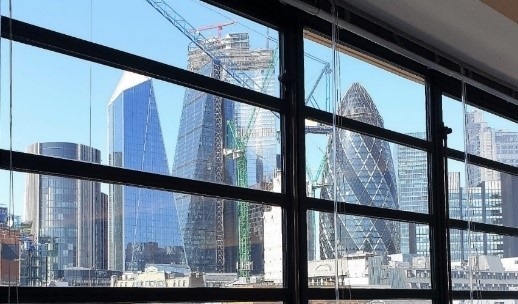‘Crossing the Pond’ 20 Years On … Part 1 of 3
In 1986, the deregulation of the UK financial markets – the ‘Big Bang’ – generated a massive building boom, and US architects began arriving in London in increasing numbers. By 1993, their growth had reached critical mass and the AIA UK Chapter was established. Six years later in 1999, the presence of US architects in London was no longer just a side story; the Americans were here for the long term.
‘Crossing the Pond’, written for Architectural Record twenty years ago, celebrated the success of large American architectural firms in the UK and reported the local market’s reaction to their ‘invasion’. This update article revisits those who took part in the original conversation – architects from (among others) SOM, KPF, HOK, Swanke Hayden Connell and Gensler - and reassesses their comments in light of today’s views. (Read original article, AR July 1999, HERE.)
[A summary list of current participants is included HERE. Their names are underlined on first reference and their comments italicised in the following narrative.]
‘The experience of the Americans working in England’, the original article asserted, ‘speaks volumes about the differences between American and British architectural practice’, but – after two decades - is it time to reconsider its analysis?
Differing Practices
In the 1999 article, the American approach was characterized as ‘large scale’ and ‘fast track’ with ‘current technology’, ‘contemporary comfort standards’, ‘modern procurement’ and ‘greater attention to detail’. Today, David Leventhal, FAIA, PLP (KPF in 1999), simplifies this, citing ‘larger plans, taller floor heights, fancy lobbies and sparse materials – it was Chicago replicated in London’.
Most of today’s participants agree with Stephan Reinke, FAIA RIBA, Stephan Reinke Architects (HOK in 1999), and David Walker, RIBA, David Walker Architects (SHC in 1999), that the early American success in producing large scale, open plan, speculative office buildings was attributable to the technological skills and know-how of the US trained architects at the time.
The first four presidents of the AIA UK Chapter 1992-1996, clockwise from upper left: Stephan Reinke, FAIA RIBA / David Walker, RIBA / Justine Kingham, AIA / Michael Lischer FAIA. (Photo credit: L King)
US architects had also credited part of their success to personal qualities – ‘problem solving abilities’, ‘can do attitude’, ‘higher productivity’, ‘sense of urgency’ and ‘entrepreneurial spirit’. Whether these traits are solely American or responsible for American success is debateable; however, in the 1980s and early 90s, American architects did have an attraction to local clients. As Stuart Lipton, then with the developer Stanhope, cautioned at the time ‘there is really no point if the people working on your project do not have experience on a US building project. We are hiring the Americans for their implementation skills.’
Accepting that local architects trailed the Americans in how to ‘draw a building, present a building, detail a building’, Lee Polisano, FAIA RIBA, PLP (KPF in 1999), recognises that branding the lighter, faster approach at Broadgate as ‘American’ also suited a developer’s narrative ‘brilliantly’. However, he cautions as simplistic the assumption that all US firms came to London with the same intention of recreating American cityscapes.
By 1999, the initial surge of experienced US staff in the UK offices of US firms had slowed. Ten years previously, at least half of SOM’s London staff were imported from the US, but a British economic downturn and the practical burdens of doing business in the UK – significant ex-pat packages, the high cost of living, work permit difficulties and the lack of reciprocity – reduced the inflow of US architects, and compelled the major American firms to rely on British or European talent. According to David Walker, even in larger firms, US experienced architects became a minority as they faced ‘an unending stream of technically talented – and less expensive - Europeans….’
David Walker Architects’ One Coleman Street: A curvilinear response to its site. (Photo credit: L King)
Skills Update
Today, most participants accept US architects are ‘no longer being hired simply because they are American’. Stephen Reinke contends their coming to the UK is now an ‘experiential, gig thing’ – taking advantage of cultural opportunities rather than offering a unique skill set. Americans can be found across a range of London practices – including their own - and are no longer concentrated in the large US firms.
Speaking from a newer generation, Alex Miller, AIA, KPF, believes there is still an advantage in the UK for American-trained architects. He maintains American architectural education ‘is more rounded, more strongly technical, more concentrated on drawings’, and his training conditions him to ‘ask pointed questions, leading to good solutions’. Justin Cratty, AIA, Gensler, goes further, adding ‘broader’ and ‘more latitude’ to the list, suggesting that American students often study architecture after previous degrees or experience and ‘have a sense they can solve bigger problems rather than just design buildings’.
Whether or not the broader education is advantageous, today’s architects quickly acknowledge that ‘problem solving abilities’ and those other positive qualities attributed to Americans by Americans in 1999 are actually characteristic of good architects everywhere regardless of national stereotypes.
Evolving Approaches
After nearly a decade working alongside Americans, Stuart Lipton concluded in the AR article that, ‘British architects have now surpassed the American practices. They have a technical knowledge and design expertise that is far superior to [that of] the Americans’.
Although there is still discomfort with Lipton’s assessment, by 1999, serious UK architects had clearly awakened to the potential of speculative office buildings – a sector they had previously foresworn – and were bringing a new flavour to them. Robert Schmidt, AIA, (SOM in 1999), now retired in Chicago, remembers ‘the UK/European staff were not afraid to question design decisions and offer their own thoughts, which resulted in a more dynamic and creative working environment’.
Kevin P Flanagan, AIA FRAIC, PLP (KPF in 1999), does not see the differences in terms of national competing teams, but stresses the evolution of a British/American ‘hybridisation’ over the past decades. ‘Whereas the Americans were considered better organised, familiar with larger projects and more business like’, he suggests, ‘American architects were also learning from the British attention to craftsmanship, organising of spatial experiences and working in an urban context’. However, having absorbed from this past knowledge base, Flanagan insists global architecture should now ‘recognise we are in the 21st century’ and grasp today’s universal and pressing issues such as sustainability and quality of working environments.
Other background factors - perceived by Americans in 1999 as drawbacks – encouraged UK-based architects to innovate. According to Roger Kallman, AIA, SOM, the British planning system took longer, added no quality and tended to ‘defeat projects’. Stephan Reinke explained that the US planning regulations were ‘prescriptive’ - designers were bound by strict rules; whereas the UK rules were ‘discretionary’ - designers could fulfil performance requirements via options. Today, Justin Cratty agrees with Reinke the discretionary UK planning regime actually provides ‘a road to progressive improvements’ instead of tying architects down.
High property costs in London were also raised in 1999 as a ‘potential project stopper’ by Susan Shoemaker, AIA. However, David Walker suggests higher property costs lead to higher budgets, which in turn allows UK-based architects to work to a higher standard and a view to longevity. One example is the uptake of European-engineered unitised systems by UK-based architects, which brought precision, factory-built facades with faster installation times, while at the same time encouraging environmental and design innovation.
PLP Architecture’s Office: Partner, Kevin P Flanagan, AIA FRAIC / Founding Partner, Lee Polisano, FAIA RIBA / Founding Partner, David Leventhal, FAIA. (Photo credit: L King)
Moreover, European design influence was not limited to facades and construction technology. There was also an emphasis on lifestyle and environmental issues that resonated not only with British designers, but with American firms such as KPF’s London office that designed exclusively for the continental market up to the late 1990s.
KPF’s Thames Court featured in the 1999 article simply as a ‘spec office building’ designed by an American firm, but the article ignored its pioneering features. Lee Polisano, however, points to its enhanced workplace environments, non-institutional organisation and even its operable windows as components of a ‘very non-American building’, evidence perhaps that American architects and their British / European colleagues were learning from each other.
PLP Architecture’s 22 Bishopsgate: Approaching its final height May 2019, as seen from PLP’s office. (Photo credit: L King)
In light of the changing scene, how have the large American firms survived and even thrived in the highly competitive UK market? Most have opened up their design approaches. Others have become more global, using the UK as a springboard to the rest of the world. Many have diversified; a few have specialised.
Written by: Lorraine Dale King, AIA






